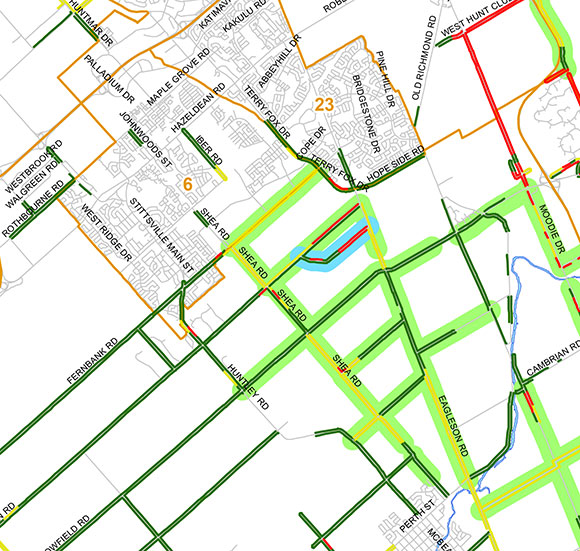(Adapted from an article originally published on the City of Ottawa web site.)
For a plant with such an innocuous name, the wild parsnip is a troublemaker. Like any invasive species, this plant is quick to spread, and seems to make itself at home just about anywhere, particularly in Eastern Ontario.
Unfortunately this intrepid greenery isn’t just a visual nuisance, but can in fact do real harm to humans. The plant sap contains chemicals that can cause skin and eye irritation and make the skin prone to burning and blistering when exposed to the sun.
The south and west areas of Ottawa are the most heavily impacted, so if you spend much time in the rural areas of Kanata or Barrhaven, be on the lookout. It’s commonly found in rural areas on uncultivated land, roadside ditches, nature trails, and areas surrounding rural and residential properties.
Most rural roads south of Stittsville have been identified as having light growth, with some parts of Shea, Flewellyn and Faulkner Trail listed as “medium” or “heavy”. The south end of Iber Road near Abbott was also identified as having “medium” growth. (See a map of growth areas here…)
You’ll know wild parsnip by its long stem and small yellow flowers. You should treat it the same way you would poison ivy: stay away.
The City of Ottawa is looking at herbicides as a one way to combat the problem. The plan is to target areas with the highest infestation, and areas where it’s most likely that people would come in contact with the plant. Signs will be posted every 100 metres in advance of the spraying so it’s very clear where herbicides will be sprayed. City crews will also be increasing roadside mowing in some areas to see how effective it is in reducing the spread of the plant.
The city plans to use herbicide on some parts of Shea, Fernbank, and Flewellyn to combat the plant.

To keep wild parsnip from spreading on your own property, mow your lawn frequently. If you spot it, you can dig out the root, but be sure to wear protective clothing and dispose of the plant extremely carefully.
Get more tips and information on how to manage wild parsnip. If you see wild parsnip or any other invasive species on city property, report it online or by calling 3-1-1.





I don’t think it’s usually called “Wild Parsnip”. It’s Giant Hogweed. See here: http://en.wikipedia.org/wiki/Heracleum_mantegazzianum
From what I understand, it looks just a far more common harmless weed called… now I’m confused… “wild parsnip”, as indicated as: “Species that can be mistaken for tall invasive hogweeds (wild parsnip, garden angelica, wild angelica)”.
I thought that these tiny bushy white flower weeds were almost always harmless, and that the invasive Asian version of it, which is much much larger, were the ones to worry about.
I now have the feeling that the city has been misidentifying this weed all over the city and that the chart is completely wrong, and they’re about to attack it with herbicide all over the place.
If it’s actualy giant hogweed, I’d say go for it, but they might only be attacking generic harmless weeds using this strategy. Are we sure it’s safe for the ground water?